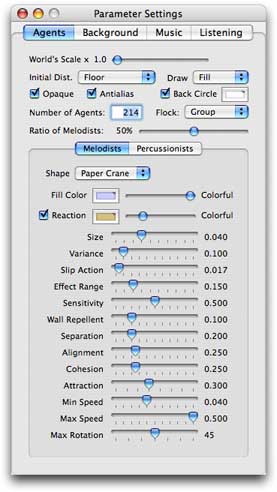
Flocking Agents
You can change the parameters to control appearance and behavior
of the flocking agents, by operating Agents
tab in the Parameter Settings window
as shown in the right figure.
You can close and open this window by selecting
Parameter Panel item in the
Settings menu.
World's Scale
Indicates the size of world where the agents move around, by scale factor.
The larger the world becomes, the smaller the agents' size and moving distances become relatively.
Appearance
- Draw ... indicates how to draw the agents by
Fill, Stroke or Both.
- Opaque ...
shows ordinary 3D agent, but if you check it off agents are drawn
as if they are transparent so that you can see video input frames
through the agents' bodies.
- Antialias ...
decides whether it draws boundaries smoothly.
It needs additional computational time for smoothing.
- Back Circle ...
decides whether a transparent circle or star at the back side of each agent is drawn
when the shape is neither Square nor Sphere.
A circle is drawn for a melodist and a start is drawn for a percussionist.
You can set up the color using a color-well at the right side
when opaque mode is on.
The Number of Agents and Species
The agents are divided into two species, melodist and percussionist.
They play different types of instruments as the names indicate.
- Number of Agents ... indicates the total number of agents.
The maxmum number is 1024. The more the agents are, the longer computational
time is needed.
- Flock ... indicates the style of flocking behavior in terms
of relations between species. You can specify one from three alternatives,
Even, Group and Mate.
Even mode does not distinguish which species the agent belongs to.
In group mode, the agents in the same species intend to organize a flock together
but not with the others. In mate mode, each agent intend to approach toward
an agent of another species.
- Ratio of Melodists ... indicates the number of agents
belonging to the specie melodist by percentage. If this value is 50%, then
the numbers of agents in two species are same.
Shape and Color Settings
The shapes and colors of the agents are set up for each species.
- Shape ... indicates the shape of
each agent. The
alternatives are Square, Sphere, Paper Plane, Paper Crane,
Box, ASCII Face and Hex ID.
- Fill Color and Reaction Color ...
indicate the color to fill the agents' body.
These parameters are ignored when the drawing method is
transparent or stroking only.
The stroke lines are always drawn in black color.
If you check the button labeled Reaction Color,
the specified color is mixed with the Fill Color proportional to the strength of
motion detected by the camera.
Behavior
The agents form a collective behavior following
BOID algorithm by C. Reynolds.
DT1 makes the users to be able to control the agnets by adding forces to attract them
toward the user's motion detected from captured frames.
- Size ... indicates the size of each agent.
- Variance ...
indicates the variance of parameter values among agents.
- Slip action ...
indicates the probability to take a random action for each step.
- Effective Range ...
indicates the radius of sphere region in which the other agents affect the agent.
- Sensitivity ...
indicates how much the agent changes its velocity for each step.
This corresponds to the mass and moment from Physics view.
- Wall Repellent ...
indicates how strong the repellent forces from walls, floor and cieling are.
- Separation ...
indicates how strong the force to separate from the other
near agents to avoid collision is.
- Alignment ...
indicates how strong the force to align the direction of agent
with the other near agents is.
- Cohesion ...
indicates how strong the force to appoach the center of the other near agents is.
- Attraction ...
indicates how strong the force to attract the agent toward
the user's motion at the front wall is.
- Min Speed ... indicates the minimum speed of agents.
- Max Speed ... indicates the maximum speed of agents.
- Max Rotation ...
indicates the maximum degree of rotation of agent in one step.
